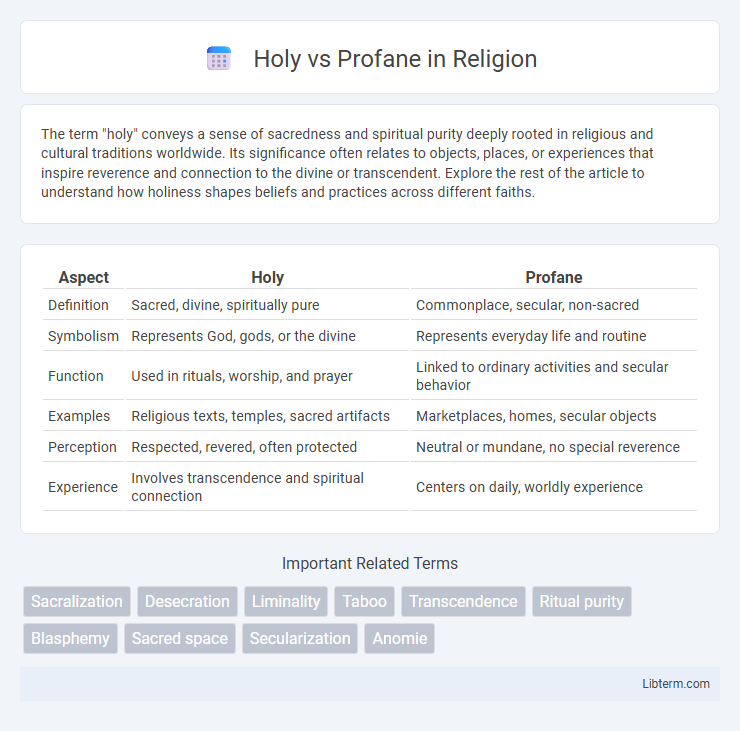The term "holy" conveys a sense of sacredness and spiritual purity deeply rooted in religious and cultural traditions worldwide. Its significance often relates to objects, places, or experiences that inspire reverence and connection to the divine or transcendent. Explore the rest of the article to understand how holiness shapes beliefs and practices across different faiths.
Table of Comparison
| Aspect | Holy | Profane |
|---|---|---|
| Definition | Sacred, divine, spiritually pure | Commonplace, secular, non-sacred |
| Symbolism | Represents God, gods, or the divine | Represents everyday life and routine |
| Function | Used in rituals, worship, and prayer | Linked to ordinary activities and secular behavior |
| Examples | Religious texts, temples, sacred artifacts | Marketplaces, homes, secular objects |
| Perception | Respected, revered, often protected | Neutral or mundane, no special reverence |
| Experience | Involves transcendence and spiritual connection | Centers on daily, worldly experience |
Understanding the Concepts: Holy and Profane
The concepts of holy and profane represent contrasting domains where the holy is associated with sacredness, divine presence, and spiritual significance, while the profane pertains to ordinary, secular, and mundane aspects of life. Understanding these terms is crucial in fields such as theology, anthropology, and religious studies, where Emile Durkheim's sociological analysis highlights how societies delineate sacred spaces and objects to foster collective identity and moral order. This dichotomy shapes cultural rituals, ethical norms, and human interactions by defining what is revered and what is considered commonplace.
Historical Roots of the Holy vs Profane Dichotomy
The historical roots of the holy vs profane dichotomy trace back to ancient religious and philosophical traditions, particularly in ancient Mesopotamia, Egypt, and later Greek thought, where sacred spaces and objects were distinguished from everyday life. Emile Durkheim's seminal work, "The Elementary Forms of Religious Life," formalized this division by defining the holy as that which is set apart and forbidden, embodying collective beliefs, while the profane encompasses mundane, ordinary existence. This dichotomy underpinned the development of religious rituals, moral codes, and social order in diverse cultures throughout history.
Cultural Interpretations of Sacred and Profane
Cultural interpretations of the sacred and profane vary widely, shaping how societies designate objects, spaces, and rituals as holy or ordinary. Sacred elements are often imbued with symbolic meaning, reflecting collective beliefs and reinforcing social cohesion through religious ceremonies and moral codes. In contrast, the profane encompasses everyday life and mundane activities, serving as a necessary backdrop that contrasts with and highlights the sacred's transcendence and sanctity.
The Role of Religion in Defining Holiness
Religion plays a central role in defining holiness by establishing sacred norms, rituals, and symbols that distinguish the holy from the profane. Through religious texts, practices, and community beliefs, holiness is conceptualized as a divine or transcendent quality that sets apart objects, places, and individuals for spiritual reverence. This separation not only structures moral behavior but also reinforces social cohesion by demarcating the sacred boundaries within a cultural context.
Profanity in Modern Society: Perceptions and Realities
Profanity in modern society functions as both a linguistic tool for emotional expression and a marker of cultural boundaries, varying significantly across social contexts and demographics. Despite ongoing debates, research indicates that the use of profane language can foster social bonding and authenticity in communication, challenging traditional notions of moral offense. The evolving perceptions of profanity reflect broader societal shifts towards tolerance and the redefinition of what constitutes the profane versus the sacred in contemporary culture.
Symbolism and Ritual: Bridging Holy and Profane
Symbolism and ritual serve as crucial mechanisms in bridging the holy and profane, transforming everyday objects and actions into sacred experiences. Rituals often utilize symbols to designate sacred time and space, reinforcing communal identity and spiritual meaning beyond the mundane. Through repeated ceremonial practices, the boundary between the sacred and profane is negotiated, making transcendent concepts tangible and accessible within cultural frameworks.
Psychological Impact of Holy vs Profane Experiences
Experiences categorized as holy often evoke profound feelings of awe, transcendence, and connectedness, triggering positive psychological effects such as increased well-being, meaning, and reduced anxiety. In contrast, encounters regarded as profane typically involve ordinary, mundane perceptions that do not significantly alter one's psychological state or sense of self. Neuroscientific studies reveal that holy experiences activate brain regions linked to emotion regulation and self-transcendence, whereas profane experiences engage areas associated with routine cognitive processing.
Art and Literature: Exploring the Holy and Profane
Art and literature frequently explore the dichotomy between the sacred and the profane, revealing deep cultural and spiritual tensions through symbolic imagery and narrative. The portrayal of holy themes often emphasizes transcendence, divine intervention, and moral virtue, contrasting sharply with profane elements that highlight human desires, earthly concerns, and taboo subjects. This interplay enriches artistic and literary works, offering profound insights into humanity's quest for meaning and the boundaries between sanctity and secular life.
Moral Implications of Distinguishing Holy from Profane
Distinguishing the holy from the profane establishes a moral framework that guides behavior, reinforcing values such as reverence, purity, and respect within society. This separation creates boundaries that dictate what is considered sacred and protects communal norms from desecration, fostering social cohesion and ethical conduct. Violating these distinctions often results in moral condemnation, emphasizing the profound impact of sacredness on collective conscience and individual morality.
The Future of the Holy vs Profane Debate
The future of the Holy vs Profane debate centers on evolving interpretations of sacredness in a rapidly secularizing world, where religious symbolism intersects with cultural and technological change. Emerging perspectives emphasize the fluidity of sacred boundaries, highlighting how digital spaces and global interconnectedness reshape notions of holiness and profaneness. Scholars increasingly explore how pluralism and cultural hybridity influence contemporary understandings of the sacred and the profane, fostering dynamic dialogues beyond traditional dichotomies.
Holy Infographic

 libterm.com
libterm.com